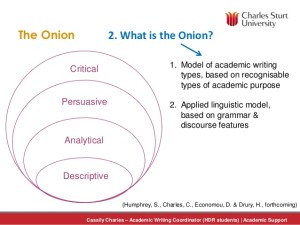Often as English teachers we give our students vague admonitions like “be specific,” “be descriptive,” and “analyze.” In “Peeling the Onion – A Textual Model of Critical Analysis,” the authors use systemic functional linguistics (SFL), especially register and genre theory, to explore the ways in which description, analysis, persuasion, and critique are patterned in the academic discourse of successful writers. The researchers look at two expert texts within the fields of Biology and Education. The authors argue that the relationships between description, analysis, persuasion, and critique can best be understood through The Onion Model (see fig. 1), “a layered model of academic writing development, which acknowledges that successful persuasive and critical writing depends on the accumulation of knowledge developed through both description and analysis” (Humphrey and Economou 37). Instead of a hierarchy, teachers can model description, analysis, persuasion, and critique as a spiral, where description and analysis serve as the basis for more complex skills.
Figure 1 The Onion: A Textual Model of Critical Analysis
Description
Academic texts traditionally rely on two different types of description: entity-focused description and event-focused description. Entity-focused descriptions, realized in noun groups, describe persons, places, things, concepts, and “received” taxonomies, while event-focused descriptions recount events, usually in material processes (Humphrey and Economou 41). Description is the most basic form of analysis, the summarization of information, often occurring in the introduction to orient the reader to the established facts of an argument.
Analysis
” What sets analysis apart from description in the Onion model is that, in analysis, information is not presented as the way things are in the field, but as the way the writer chooses to represent information in the field in order to address the concerns of their text.” (Humphrey and Economou 42)
Description is different than analysis in that established facts and “received” taxonomies are reorganized in creative and original ways. Analysis tends to flow over large bodies of text, such as with organizational headings, creating an original framework for a text (Humphrey and Economou 43). Analysis can be expressed through the creation of abstract entities, through nominalization, as well as by comparing and contrasting categories (Humphrey and Economou 43).
Persuasion
In persuasion, the writer takes a specific stance on a position, using scholars for support. Humphrey and Economou explain persuasion generally “unfolds through three stages: thesis (or overall position); arguments; and reinforcement of thesis” (43). At the phase level, persuasion results from a claim backed by grounds. Interpersonal, appraisal resources are necessary for persuasion, making evaluations, expressing judgments, as well as establishing rapport with the reader, proving multiple perspectives have been taken into account.
Critique
Critical analysis is the most advanced stance a writer can take. Critical analysis involves the challenging of established authorial opinions, convincing the reader of an alternative. A critical stance involves pointing out an argument is flawed or limited in some way and is most often set forth in the introduction (Humphrey and Economou 47). Critical analysis uses appraisal resources, like persuasion, but also employs negative evaluations, such as so-and-so’s argument is flawed, overstated, limited, etc. (Humphrey and Economou 47).
Conclusion
The Onion Model describes the academic stances of description, analysis, persuasion, and critical analysis as a recursive spiral rather than a hierarchy. The model clearly illustrates that writers are dependent on basic forms of analysis before achieving the more complex levels of persuasion and critique.
Although this model was originally developed for English Language Learners, I believe all my students in first-year writing could benefit from it. I especially like the genre analysis of persuasion and critique, analyzing the linguistic and appraisal features that help express more sophisticated academic stances. Pointing out to students the linguistic features of description, analysis, persuasion, and critique can make tangible the techniques students need to achieve persuasive and critical writing. Research into genre and writing for academic purposes ties into my larger goals of exploring ways to make language instruction well-informed and clearer for all students.
Works Cited

